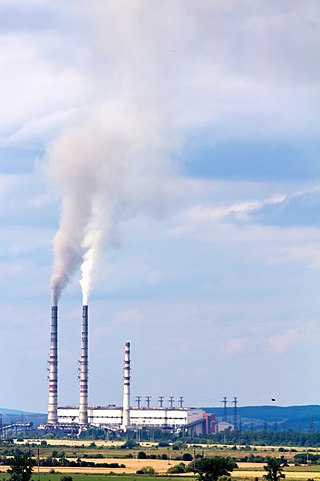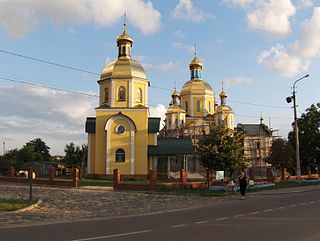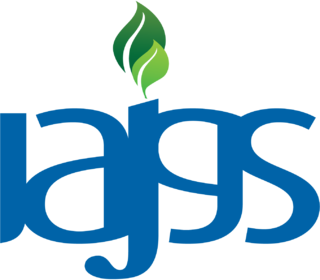
Belz is a small city in Lviv Oblast, western Ukraine, located near the border with Poland between the Solokiya river and the Richytsia stream. Belz hosts the administration of Belz urban hromada, one of the hromadas of Ukraine. Its population is approximately 2,191.
The history of the Jews in Bessarabia, a historical region in Eastern Europe, dates back hundreds of years.

Burshtyn is a city located in Ivano-Frankivsk Oblast, in western Ukraine, to the north of Halych. It is accessible by rail. Burshtyn hosts the administration of Burshtyn urban hromada, one of the hromadas of Ukraine. Population: 14,737.

Berezhany is a city in Ternopil Raion, Ternopil Oblast, western Ukraine. It lies about 50 km (31 mi) from the administrative center of the oblast, Ternopil. The city is about 400 metres (1,300 ft) above sea level. The yearly temperature in Berezhany ranges from −35 °C (−31 °F) in winter to 40 °C (104 °F) in summer. Berezhany hosts the administration of Berezhany urban hromada, one of the hromadas of Ukraine. Population: 17,139.

Galician Jews or Galitzianers are members of the subgroup of Ashkenazi Jews originating and developed in the Kingdom of Galicia and Lodomeria and Bukovina from contemporary western Ukraine and from south-eastern Poland. Galicia proper, which was inhabited by Ruthenians, Poles and Jews, became a royal province within Austria-Hungary after the Partitions of Poland in the late 18th century. Galician Jews primarily spoke Yiddish.
Gary Mokotoff (born April 26, 1937) is an author, lecturer, and Jewish genealogy researcher. Mokotoff is the publisher of AVOTAYNU, the International Review of Jewish Genealogy, and is the former president of the International Association of Jewish Genealogical Societies (IAJGS). He is the creator of the JewishGen's Jewish Genealogical Family Finder and the Jewish Genealogical People Finder. He co-authored the Daitch–Mokotoff Soundex system. Mokotoff is co-author of Where We Once Walked: A Guide to the Jewish Communities Destroyed in the Holocaust.

The history of the Jews in Moldova reaches back to the 1st century BCE, when Roman Jews lived in the cities of the province of Lower Moesia. Bessarabian Jews have been living in the area for some time. Between the 4th-7th centuries CE, Moldova was part of an important trading route between Asia and Europe, and bordered the Khazar Khaganate, where Judaism was the state religion. Prior to the Second World War, violent antisemitic movements across the Bessarabian region badly affected the region's Jewish population. In the 1930s and '40s, under the Romanian governments of Octavian Goga and Ion Antonescu, government-directed pogroms and mass deportations led to the concentration and extermination of Jewish citizens followed, leading to the extermination of between 45,000-60,000 Jews across Bessarabia. The total number of Romanian and Ukrainian Jews who perished in territories under Romanian administration is between 280,000 and 380,000.

Berezne is a city in Rivne Oblast, Ukraine. It is located on the Sluch River north of Rivne. It was the administrative center of Berezne Raion until it was merged with Rivne Raion in 2020. Population: 13,126.

Bolekhiv is a city in Kalush Raion, Ivano-Frankivsk Oblast, Ukraine. It was once home to a large Jewish community, very few of whom survived World War II. Bolekhiv hosts the administration of Bolekhiv urban hromada, one of the hromadas of Ukraine. Population: 10,259.

Otaci is a town on the southwestern bank of the Dniester River, which at that point forms the northeastern border of Moldova. On the opposite side of the Dniester lies the Ukrainian city of Mohyliv-Podilskyi, and the two municipalities are connected by a bridge over the river. Otaci is located in Ocnița District.
Benjamin Meed, a Polish Jew, fought in the Warsaw ghetto underground, served on the Advisory Board of the President's Commission on the Holocaust, planned the 1981 World Gathering of Jewish Holocaust Survivors and the 1983 American Gathering of Jewish Holocaust Survivors held in Washington, D.C., and other reunions that followed, and was President of the American Gathering of Jewish Holocaust Survivors and their Descendants.
The American Gathering of Jewish Holocaust Survivors and Their Descendants, also known as the American Gathering, is the largest organization of Holocaust survivors in North America. It functions as an umbrella organization for survivor resources, offering both services and advocacy. The American Gathering is active in Holocaust remembrance, education and commemoration programs. From 1983 onwards, the organization has held national reunion events.

The Jewish cemetery of Khotyn, Ukraine.

JewishGen is a non-profit organization founded in 1987 as an international electronic resource for Jewish genealogy. In 2003, JewishGen became an affiliate of the Museum of Jewish Heritage – A Living Memorial to the Holocaust in New York City. It provides amateur and professional genealogists with the tools to research their Jewish family history and heritage.

The International Association of Jewish Genealogical Societies, Inc. (IAJGS) is an independent non-profit umbrella organization coordinating the activities and annual conference of 84 Jewish genealogical societies worldwide.
Nimereuca is a commune in Soroca District, Moldova. It is composed of two villages, Cerlina and Nimereuca.

Jewish genealogy is the study of Jewish families and the tracing of their lineages and history. The Pentateuchal equivalent for "genealogies" is "toledot" (generations). In later Hebrew, as in Aramaic, the term and its derivatives "yiḥus" and "yuḥasin" recur with the implication of legitimacy or nobility of birth. In Modern Hebrew, genealogy is generally referred to as "שורשים"/"shorashim", the Hebrew word for roots, or borrowing from the English, "גנאלוגי"/"genealogi".

Bohuslav is a city on the Ros River in Obukhiv Raion, Kyiv Oblast, Ukraine. It hosts the administration of Bohuslav urban hromada, one of the hromadas of Ukraine. Population: 15,789 ; 17,135 (2001).

Miriam Weiner is an American genealogist, author, and lecturer who specializes in the research of Jewish roots in Poland and the former Soviet Union. Weiner is considered to be one of the pioneers of contemporary Jewish genealogy through her work to open up archives and is described as a trail-blazing, highly respected guide and leading authority on archival holdings and resources in pre-war Belarus, Lithuania, Moldova, Poland, and Ukraine.

Jewish Roots in Poland: Pages from the Past and Archival Inventories is a book created by genealogist Miriam Weiner and co-published by The Miriam Weiner Routes to Roots Foundation and YIVO Institute for Jewish Research. A searchable database of updated archival holdings listed in the book is available in the Archive Database on the Routes to Roots Foundation website.

















